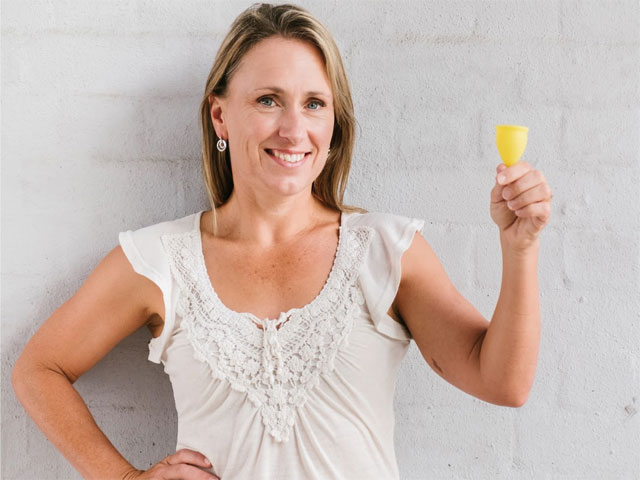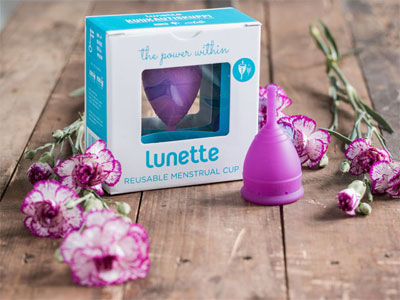Elizabeth Chapman Lunette Interview

An Environmentally Conscious Health and Wellbeing Trend
Lunette is an international business with the goal of making your period a little easier using menstrual cups. Lunette menstrual cups are designed, developed and packaged with the environment at heart. It's also the best alternative to disposable period products which pollute our planet.
Interview with Elizabeth Chapman, Distributor of Lunette in Australia
Question: What is a Lunette Menstrual Cup?
Elizabeth Chapman: The Lunette menstrual cup is bell-shaped cup that gives you a comfortable, safe, odorless and eco-friendly period for up to 12 hours a day.
It's also reusable and lasts several years meaning less time, money and stress!
The Lunette menstrual cup is the future of period care.
Less spending: Ditch the regular dash to the store and protect your purse strings with the best reusable choice that lasts several years.
Healthier you: Lunette menstrual cups collect fluids rather than absorbing them, keeping your superior interior naturally lubricated and healthy.
Happier planet: No more endless purchases, plastics and packaging. Every period with your reusable Lunette menstrual cup is a winning vote for the environment.
More control: Unlike tampons, you never "run out" of Lunette. Like an invisible sidekick it runs around with you either in a handy, cute pouch or sitting comfortably inside you. Meaning you can say goodbye to the worry, the hassle, the leaks and just live your life.
Question: How does a menstrual cup encourage sustainable health?
Elizabeth Chapman: There are six million Australian and New Zealand people of menstruating age. Each of them will use about 22 disposable sanitary products per period cycle – or 11,000-16,000 in their lifetime. In stark comparison, one Lunette menstrual cup will last 10 years.
Every woman disposed of about 1 wheelie-bin worth of sanitary items into landfill each year. Lunette cups not only save money, cost and time, they are also far better for your health and the environment. Did you know Tampons alone add up to 140kg of waste, and 75% of blocked drains in urban areas of Australia are caused by flushed sanitary items.
Question: What should we know before buying and using a menstrual cup?
Elizabeth Chapman: Follow these handy tips before using and removing your cup:
Relax and take your time: Choose alone time when you can focus without distractions or interruptions. Perhaps after a warm bath when you are relaxed. If you are too nervous, the vaginal muscles will tighten, making it uncomfortable, if not impossible, for successful insertion.
Get Acquainted with yourself: It is always a good idea to know your own body. Take some time to locate the vaginal opening and even insert a finger to locate your cervix. It feels exactly like the tip of your nose. Knowing where your cervix is will help you to position the cup properly and not insert it too high.
Practice during your period: The vagina is more flexible and the blood works as a lubricant. OR …
Take a "dry run" before your period: You might be more comfortable practicing before your period if you feel squeamish about touching blood. In this case, use water as a lubricant.
Try different folds that accentuate the insertion point: Most women use the typical C-fold. However, there are many ways to fold a Lunette. The video here will show you nine different folds.
Proper insertion direction: Be aware that the direction of insertion needs to be aimed towards the small of your back - not straight up.
Be patient: It can take a few cycles to become a menstrual cup pro as it's quite different to a tampon. If you begin without the expectation of perfect insertion, you are more likely to be relaxed and pleasantly surprised when success happens.
Do NOT pull on the stem: The stem is used to gain access the bottom of the cup. If you pull on the stem (like a tampon string), it will hurt! It will also create a mess since the cup won't be supported or controlled when it exits.
Squeeze bottom to release suction: This is the key - the bottom of the cup has ridges for gripping. Grip the bottom and tweek the cup to the side. The idea is to pull an edge away from the vaginal wall to release suction. You will hear it when this happens.
Rock gently: Once suction releases, gently rock the cup from side to side as you pull it out. This technique might not be necessary, but helps with removal if the cup is feeling stubborn to come out.
Assess the stem: Once inserted, you will need to decide whether or not to keep the stem. If it protrudes, it will be uncomfortable. In this case, you likely won't need the stem and can trim it off. However, if not, you may need it to assist with removal.
 Question: When did you begin an environmentally conscious lifestyle?
Question: When did you begin an environmentally conscious lifestyle? Elizabeth Chapman: Our environmentally conscious lifestyle is more of a journey, and one that continues to evolve. It begun properly 11 years ago with switching to menstrual cups-and since then has grown with many small steps introduced 1 at a time - from simple recycling in our council garbage bins, to conscious recycling of paper/cardboard, soft plastics, bottles/cans, not purchasing new clothes, zero waste lunches for children, worm farm, compost bins, buying unpackaged groceries where possible, utilising public transport, painting our roof a light colour, installing solar panels…. and so it continues - one change at a time.
Question: Why is being an ethical and sustainable brand, important to you?
Elizabeth Chapman: We place a high value in quality, equality and honesty. We respect how hard people work for their money, and want to offer an exceptional return on investment in terms of value and life improvement. We strive in our daily lives to be the best version of ourselves, and to make our planet the best that it can be. We also expect this from the products that we endorse. It is part of who we are.
Question: How does Lunette decrease their footprint by implementing eco-friendly practices?
Elizabeth Chapman: Our products are vegan, cruelty free, and even the clear window in our packaging is made from a biodegradable plant based cellulose, as well as recycled cardboard. Our cups should last for 10 years, and afterwards can be disposed of by burning - leaving practically no carbon footprint. Lunette Australia in February 2018 launched the world first Sustainable Period Project - a grass roots educational program for high schools to teach about how to manage your period sustainably.In collaboration with other sustainable period companies, we are sending out a fee resource kit to every high school across Australia and New Zealand. We are serious about sustainability!
Question: How are you reducing your plastic consumption at home and in the office?
Elizabeth Chapman: We try to be as paper-free as possible, and print minimally on recycled paper. Any soft plastics and materials that we receive from shipping is recycled. We use our own mugs-zero take away containers. We use refillable ink cartridges in our printers. We are solar powered.
Question: What's a typical day like, for you?
8.45-9am. Start Lunette from the home office. Short lunch break. Alarm goes at 2.29pm to collect children from school. Afternoon taxi service for children, family time. Sometimes walk or swim whilst they are at activities.
Check some more emails, Bed around 10pm.
Question: What's next for Lunette?
Elizabeth Chapman: Our Sustainable Period Project is very important to us. We want everybody to not only know of Lunette cups existence, but for it to be their menstrual product of choice. We wish for everybody to use sustainable menstrual products and to have access to them. We want to significantly reduce landfill. We want period positivity-for periods to be seen as normal and non-taboo by every age and gender. Watch us change the world-one cup at a time!
Interview by Brooke Hunter
MORE



